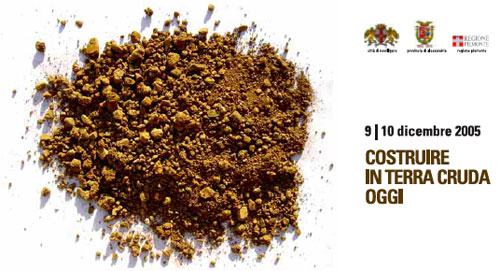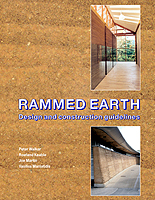
The Renaissance of Rammed Earth with David Easton (video 30 minutes), offers complete construction information, and interviews with people who live in these solid walled homes.

Architecture, Art, Design, and Culture using of mud, clay, soil, dirt & dust.

The Renaissance of Rammed Earth with David Easton (video 30 minutes), offers complete construction information, and interviews with people who live in these solid walled homes.
Rammed Earth is for Everyone, claims this new blog devoted to rammed earth. Good bibliographies and examples of soil mockups.
The Earthen Architecture Association, headquartered in the Czech Republic, is an organization whose members are interested in Earthen Architecture and natural materials, promotes use of clay in new buildings and protection and preservation of existing clay houses as a part of our cultural heritage.

Building with Raw Earth Today: International Conference on the Preservation, Promotion and Protection of Earth Architecture. December 9-10, 2005. Download conference schedule [Italian Language]

An Architecture for People: The Complete Works of Hassan Fathy reviews the ideas and designs of Egyptian architect Hassan Fathy (1900-1989), best known for his striking Architecture for the Poor (University of Chicago, 1973), which described his efforts to create the village of New Gourna for 7,000 displaced Egyptian peasants known as the Gourni. Fathy sought to empathize with their lifeworld and to find architectural means whereby the new village would sustain their traditional way of life yet at the same time make life better by drawing on sustainable technology.
Steele, an architect himself, presents Fathy’s built projects and discusses the design philosophy underlying his work. Steele’s book is a tribute to Fathy as a compassionate designer and as a master craftsman who held strongly to traditional values and beliefs at a time when the historical amnesia and standardization of Modernist architecture dominated.

Rammed Earth: Design and Construction Guidelines by Peter Walker and BRE promotes the use of rammed earth wall construction in the UK as a high-quality and sustainable building technology. In one book it gives detailed practical guidance on architectural details, structural engineering recommendations, material selection, construction and maintenance of rammed earth.
The Earth Building Research Forum was set up by Dr Kevan Heathcote and Mr Gregory Moor in the Faculty of Design Architecture and Building of UTS in December 1999. It was originally envisaged as a forum for disseminating ideas and research into the performance of earth buildings but has since been widened to include a database of earth building projects, information on forthcoming conferences, linkages to other earth building sites and to include more general articles on the subject. The Forum hosted an international earth building conference at UTS in January 2005 (EarthBuild 2005) and this is planned to be a biennial event. The Conference brought together engineers, environmentalists, builders and architects from around the world.
Earthen architecture in Iran and Central Asia: its conservation, management, and relevance to contemporary society, a celebration of the life and work of Robert Byron, will be held at the Institute of Archaeology, University College London, 12-13th November 2005. The aim of the conference is to bring together individuals involved in the conservation and management of the archaeological and architectural legacy of earthen architecture in Iran and Central Asia, to discuss current approaches, practical applications, new projects and the impact of work on local communities and contemporary society.
O 4? Seminário Ibero-Americano de Construção com Terra e 3? Seminário de Arquitectura de Terra em Portugal, Convento da Orada, Monsaraz, Portugal, 7 > 12 Outubro 2005, reunirá mais de 300 especialistas na área, e terá como principais objectivos: contribuir para a melhoria na qualidade de construção e protecção do património; preparar mais adequadamente técnicos nacionais, regionais e locais a intervirem com maior conhecimento e responsabilidade no património em terra urbano e rural, assim como em áreas protegidas; aprofundar a investigação, logo contribuir para um desenvolvimento local mais sustentável, por meio de um maior conhecimento da conservação do património, da difusão de arquitectura contempor‚nea utilizando materiais tradicionais, da utilização de materiais com maior eficiÍncia energética, assim como de estratégias para formação local, com maior integração social.